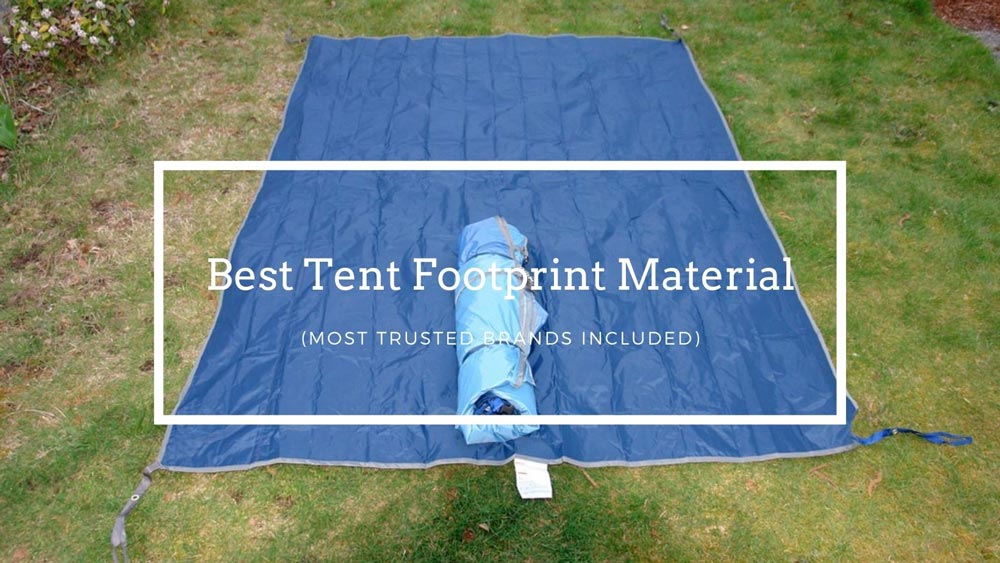Has it ever happened that you were stuck in the middle of a sudden downpour while trekking?
With no one to help you in the wilderness, the only protection is to set up your tent and crawl inside. However, the wet ground will still soak you without a suitable footprint to keep the water out.
So, today, we’ll be looking at the best tent footprint material to ensure that you have one less thing to worry about on your next adventure.
Best Tent Footprint Material Options
My favorite footprint, the best I’ve found for ultralight backpacking and hiking, is a do-it-yourself project. The factory options specifically designed for your tent aren’t good enough. They’re expensive and come with clips and buckles to attach them to the bottom of your shelter – making them unnecessarily heavy too!
The DIY is a great option for ultralight backpackers. It’s easy to make your footprint with the following materials you already have at home or can find locally (at Walmart/Target etc.), so it won’t cost much more than $10-$20 max!
Window Insulation Film/Polycryo
For those who don’t know, Polycro or window insulation film is a thin and clear plastic sheet that helps cover windows. While it cuts down on energy costs in domestic settings, campers can use it as a tent floor in rugged areas or place it under the tarp.
Needless to say, it offers added protection against rainwater, and there are several sizes to choose from, making it compatible with different tents. We must mention that it is extremely lightweight and perfect for expeditions since it doesn’t affect mobility.
Window insulation film is available in a wide range of sizes and shapes. My favorite brand is Duck Brand Large Window, which comes in all sizes and works great for cutting out a footprint for my backpacking tent. Very thin and durable!
Tyvek
If you’re looking for a softer and quieter tent footprint material, we suggest buying Tyvek fabric. Builders predominantly employ it for construction purposes, but you can also use it for camping, given its pliable and durable property.
You can rest assured that it will keep out rainwater, thanks to its water-resistant properties. Meaning, you will be able to enjoy a goodnight’s sleep even in unpredictable weather conditions.
In addition, it costs less and promises to meet most of your outdoor needs, which will please most buyers.
Survival Blanket
To survive in the wild, you need a reliable material that won’t tear or wear out after regular use. Naturally, a survival blanket acts as an excellent tent footprint material, making it worth the investment.
You will love its reflective nature, thereby ensuring that it is ideal for camping in different weather conditions. Be it heat, rain, snow, or wind; this durable material will protect against natural elements without any difficulty.
Polycryo Vs. Tyvek
Both Polycro and Tyvek have their advantages, but there are situations where one is better than the other. For instance, the abrasion-resistant properties of Polycro make it ideal for camping in mountainous terrain consisting of rocks and roots.
Polycryo is the perfect choice for a tent floor that needs to be lightweight. Tyvek is the way to go if there’s no floor or especially with an air pad involved.
Tyvek is a little heavier, but one of the best features is that it becomes softer as it gets used over time. It would feel more comfortable, not as sticky or clingy as Polycro.
On the other hand, Tyvek offers more reliability in windy conditions and prevents the tent from collapsing. Not to mention, it is affordable and suitable for people on a tight budget.
Author tip: You can put Tyvek on the gentle a cycle or two will make it softer and quieter. Don't add detergent, just water.
What To Consider To Choose The Best Tent Footprint Material?
Lightweight
The weight of a tent footprint depends on the size and thickness of the material. In other words, a thicker product that weighs more and is larger compared to smaller models is required to balance the extra weight.
We would recommend choosing a lightweight tent footprint for more flexibility and easy maneuverability.
It would help if the tent footprint weighed less than 20 ounces, ensuring that you get the right amount of protection without going overboard.
Good For Cutting
It is essential to ensure that it is easy to cut for making your own polycryo A-Frame tarp. The trick is to cut them down to size or even fold small pieces together for the perfect fit. Polycryo and Tyvek are the best options if you plan to cut them. The survival blanket reflects more heat but is not so good for cutting.
You can draw a circle around the perimeter of the tent to mark out the desired area, then cut three inches inside the circle, thereby leaving enough room if you make a mistake or cut wider. This will keep the rainwater off the tent while also making sure that water flowing down the hillside will pass underneath.
Durable
Speaking of durability, you must ensure that the tent’s footprint can bear the outdoor conditions without deteriorating. Before making the purchase, consumers need to check the Denier number to determine the product’s robustness.
Now, this number is the weight and thickness of the fabric that distinguishes the top models from the cheap units. A tent footprint with a higher Denier number provides more reliability compared to brands using a similar fabric.
In addition, if it has “ripstop” technology, you can rest assured that the fabric won’t strip or tear.
Easy To Carry
We have already mentioned the benefits of using a lightweight tent footprint, but there is another advantage that we must mention. A lighter tent is easier to carry, allowing you to camp in any suitable spot.
But especially pleasing is the fact that you won’t get tired even after trekking throughout the day. Hence, you won’t feel bogged down due to the extra weight.
Price
Finally, the cost of the product is a deciding factor for many buyers, which is understandable given the range of options available out there. Naturally, no one would want to spend their savings on a costly tent footprint material as there are other pieces of camping equipment to buy.
That said, you should not compromise on quality and look for models that will last a long time. Also, we have seen that the top brands tend to cost more, so it would be best to have a flexible budget.
Do These Tent Footprint Material Have Insulative Capabilities?
Footprints made from Polycro and Tyvek can protect from moisture and keep your tent dry when you have to pitch on damp or wet ground. All of the footprint materials that we have mentioned are insulative and keep you warm.
Whether Tyvek or Polycro, they are made of high-density polyethylene, which has excellent insulation properties.
Final Thoughts
That’s all there is to know about tent footprint materials; hopefully, now you can make the right pick.
It would be best to choose the tent size you need before buying a suitable tent footprint. Also, research the area you will be camping in to ensure that the product can protect you from the natural elements.
On that note, we wish you a safe camping trip. Bye!


